
The Purr-fect Solution: A Comprehensive Guide to Indoor Cat Door Installation
As any cat owner understands, providing a safe and convenient method for felines to go into and exit your home can be a challenge. Traditional doors typically posture an issue, as they can be difficult for felines to open and close, and may even pose a danger of unintentional escape or injury. This is where indoor cat doors been available in-- a basic, yet efficient solution that enables your feline friend to come and go as they please, while preserving the comfort and security of your home.
In this short article, we will dive into the world of indoor cat door installation, checking out the benefits, types, and installation procedures involved. Whether you're a seasoned DIY lover or a novice property owner, this thorough guide will offer you with all the information you need to produce a purr-fectly working cat door expert door for your feline buddy.
Benefits of Indoor Cat Doors
Before we dive into the installation process, let's take a look at the benefits of indoor cat doors:
• Convenience: Indoor cat doors allow your cat to come and go as they please, removing the requirement for constant door opening and closing.• Energy Efficiency: By minimizing the variety of times you need to open and close standard doors, indoor reliable cat flap fitter doors can assist minimize heat loss and gain, making your home more energy-efficient.• Safety: Indoor cat doors minimize the risk of accidental escape or injury, as your cat can safely get in and exit the home without the threat of being caught or struck by a closing door.• Reduced Stress: Indoor cat doors can help in reducing stress and stress and anxiety in both felines and owners, as they get rid of the need for constant door tracking and create a more tranquil living environment.
Types of Indoor Cat Doors
When it comes to indoor reliable cat flap fitter doors, there are several types to pick from, each with its own special characteristics and advantages:
- Magnetic Cat Doors: These doors utilize a magnetic closure system to keep the door shut, and are perfect for smaller sized felines and kittycats.
- Spring-Loaded Residential Cat Flap Installers Doors: These doors use a spring-loaded system to keep the door shut, and appropriate for bigger felines and multi-cat homes.
- Electronic Cat Doors: These doors use sensors and motors to manage access, and are best for tech-savvy owners who want a state-of-the-art option.
- Handbook Cat Doors: These doors require manual opening and closing, and are perfect for owners who choose a more traditional approach.
Installation Process
Installing an indoor cat door is a fairly simple process that requires some standard DIY abilities and tools. Here's a detailed guide to help you get begun:
Tools Needed:
- Drill and bits
- Screwdriver and screws
- Determining tape
- Level
- Pencil and marker
- Shatterproof glass and a dust mask (optional)
Step 1: Choose the Perfect Location
When choosing the perfect location for your indoor cat door, consider the list below elements:
- Traffic: Choose an area with very little foot traffic to avoid accidents and tension.
- Ease of access: Ensure the area is easily accessible for your cat, and preferably near a food source or litter box.
- Environment: Avoid locations with severe temperature levels, wetness, or drafts.
Action 2: Measure and Mark the Door
Measure the width of your cat door and mark the center point on the wall or door frame. Utilize a level to guarantee the mark is straight, and a pencil to draw the line along the length of the door.
Step 3: Cut Out the Door
Utilize a drill and bits to eliminate a hole for the cat door, following the maker's instructions for size and shape.
Step 4: Install the Door Frame
Set up the door frame, guaranteeing it is level and protect. Usage screws to connect the frame to the wall or door frame.
Step 5: Add the Door Panel
Attach the door panel to the frame, following the producer's directions for assembly and installation.
Step 6: Test the Door
Check the door to ensure it is operating effectively, and make any essential modifications to the positioning or stress.
Often Asked Questions (FAQs)
Q: How do I pick the right size cat door for my pet?

A: Measure your cat's width and height to determine the ideal door size. Seek advice from the producer or a pet expert for guidance.
Q: How do I prevent drafts and wetness from going into through the cat door?
A: Install a weatherproof seal or threshold to reduce drafts and moisture. Routinely tidy and maintain the door to prevent damage.
Q: Can I set up an indoor cat door in a load-bearing wall?
A: It is advised to prevent setting up cat doors in bearing walls, as this can jeopardize the structural stability of your home. Seek advice from a professional if you're not sure.
Q: How do I keep other animals or pests from getting in through the cat door?
A: Install a safe locking system or utilize a magnetic closure system to avoid undesirable entry. Consider including a screen or mesh to keep insects and insects out.
Tips and Tricks:
• Add a ramp or action: Create a comfy and safe entry point for your cat by including a ramp or action.• Use a soft-close system: Reduce noise and tension by setting up a soft-close mechanism that slows the door's closure.• Regularly tidy and maintain the door: Keep your cat door fitting door in top condition by regularly cleaning up and keeping the door and its components.
In conclusion, installing an indoor cat door is a basic and efficient way to produce a comfortable and practical living environment for your feline good friend. By following this thorough guide, you can develop a purr-fectly working cat door that satisfies your pet's needs and improves your home's convenience and security.


